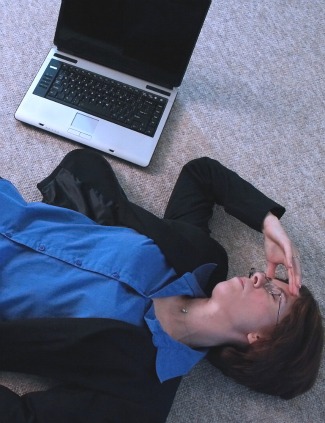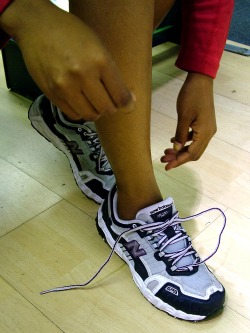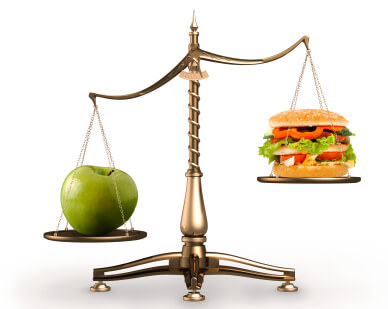
Yep, that's pretty much how it felt...
So, after being accused of pharmacy-shopping, I was a little floored, as you can imagine.
Standing there in the Walgreens’ pharmacy waiting area, having just raised my voice considerably, I became acutely aware of people staring at me. I felt a sudden rush of shame, of all things. I’m not even sure a coherent thought or rationale attached to that emotion — just a hot rush of shame.
But what did I have to be ashamed of?
It didn’t really matter, I realized. Because to any casual observer, I was the woman screaming at a doctor’s office at a pharmacy. Clearly, I was drug-seeking and had been turned down. Right?
No, of course not. Wrong, wrong, wrong. But try explaining that to someone — anyone. The futility of defending yourself against implications of this kind was rammed home with particular force a few days later, but there and then, in the Walgreens, I decided I didn’t care what these strangers thought of me. I took my fourteen pills and went home to plot my next move.
I’d decided initially to file a formal complaint — something I’d never done in my entire life. My state’s medical licensing board’s website contained everything I needed to know to get that process started. Yet something made me pause for a moment. I wanted to know who, exactly, I was dealing with.
That’s when I found out that my provider — the one who was on vacation — was a physician’s assistant, not an M.D. That didn’t matter to me so much — P.A.s are great, in my experience. But the doctor who was covering her wasn’t just a full-fledged M.D. – she was the chief M.D. for this practice. She was the boss, in other words.
So what was going on here? Had my P.A. violated some clinic policy in giving me the prescription in the first place? Would complaining about the doctor get the P.A. in trouble? Did I care?
I actually began to consider not saying anything to anyone.
That embarrasses me now, in retrospect. Me, the health and chronic pain blogger — the woman who preaches the need for patients being their own best advocate — I was considering letting this whole mess slide without comment.
What kind of hypocrite would I be if I remained silent?
So, yeah, I had to say something. But to whom? And how?
I did a little more research on the medical licensing board site. There, I discovered something that appalled me: doctors in my state could discharge patients — refuse to treat them altogether — if the patient lodged a formal complaint!
This may not be news to anyone but me. It certainly knocked me for a loop, and suddenly I had a much bigger concern. It had taken me months to find a practice with fees I could afford. There were very few remaining options for medical care, and given my conditions — scoliosis, degenerative disk disease, fibromyalgia — all incurable, all chronic, all very painful — I couldn’t risk losing access to a doctor.
Even one that thought I was an addict? It felt at that moment like an unsolvable problem.
Then a middle ground approach occurred to me. I brought up my email program and began to write. Using the chief doctor’s email address, which I found on the practice’s website, I composed an email to her.
In that email, I laid out my medical history pertaining to my chronic pain conditions. I discussed this blog. I told her where I stand on the intrusion of law enforcement into medical care decisions. As I wrote, I was vaguely aware of how important this email was — more important than any blog post or email I’ve ever written. This email was my last hope to get the care I desperately needed.
I’ve edited out the identifying information from that email, and turned it into a PDF, so I can share it with my readers. You can get that file here (PDF link). But I wanted to share one excerpt here — after recounting the facts of what happened (which you can read in the first post, here), I wrote:
I don’t know if you can appreciate the feeling of humiliation and frustration that naturally arises when you’re placed in such a position. I felt unjustly accused and labeled, without any justification for such treatment. You have never seen me professionally, nor do we have any sort of relationship. We have never even met. Yet, simply because I called and asked for a refill for a medication that I have taken without incident for over six years, you apparently assumed that I was a drug addict.
I have never experienced this before, in over ten years of being a chronic pain patient. If I handled it badly, I apologize. Yet I maintain that I have not been treated with dignity and respect, and I have given you absolutely no reason to question the legitimacy of my treatment protocol, of which medication is an important (though certainly not the only) part.
I have maintained a website devoted to patient advocacy in the chronic pain context for several years, most recently at https://www.eustonarch.org. Even so, I confess I feel some trepidation even writing this email to you, for fear you may retaliate by dropping me as a patient from your clinic’s family practice. This sort of chilling effect is not conducive to good patient/doctor relationships or to the practice of good medicine, as I’m sure you realize. I see from the clinic’s website you are the medical director for the clinic. In such a leadership position, I am sure you would want a patient to feel free to raise a legitimate concern over his or her medical care. Yet even I, with my educational opportunities and background, and with my professional interest in patient advocacy, thought long and hard about writing this email.
I re-read that email several times, and though I was generally pleased with it, I was still very nervous about rocking the boat with this clinic. So I decided to ask for the input of two people I trust, and sleep on it myself. The next morning, having received full-throated approval from both friends and feeling somewhat stronger emotionally myself, I sent the email.
Within a few hours, I received a telephone call from the clinic’s main number. It was Dr. C, another M.D. who was apparently Dr. A’s second in command. He told me Dr. A had asked him to deal with my situation and forwarded the email to him. Right off the bat, he apologized for the miscommunication and the way I’d been treated, which earned him some goodwill from me.
The very next thing he said was, “I’ve already called in another 21 pills for you. That should be enough to get you to your appointment with Ms. B.”
Phew. “Thank you,” I said. “I do appreciate this.”
“There’s just one thing, though,” he continued, sounding hesitant. “We went back and double-checked your medical records and you should have had enough tramadol from that refill to last to the end of the month.”
It was the 21st of April.
For the second time in 24 hours, I was flabbergasted. This time, however, words failed me. I sputtered and stammered something like “I don’t think that’s right…” as I frantically searched for a calendar and my old bottle of tramadol, to match up the dates.
Pretty quickly, I realized that my addled brain wasn’t up to the simple addition and multiplication tasks inherent in figuring this out. Somehow, I managed to catch my breath, calm down, and say somewhat intelligently, “I’m not sure what happened there, but I will certainly look into it immediately and discuss it with Ms. B next week.”
He said that was fine, and he apologized one more time before hanging up.
OK, I thought, trying to calm my racing heart, this is a very different scenario. My mind raced back through the last four weeks, trying to figure out what had happened, and when. I knew I hadn’t taken more than the prescribed dosage, so when I got to the bottom of the pill bottle, I just naturally assumed it had been four weeks. But after consulting the calendar and doing the math, I had to admit that Dr. C was right: I was off by about 21 pills.
What had happened? When had it happened? This was pretty much all I thought about for the next two days. I retraced my steps mentally, going all the way back through a very busy month in which I’d moved (yet again) and coped with all the stress that brings.
Was it possible I’d taken more tramadol than I was supposed to, or been careless with the pills and dropped them, somehow? That didn’t seem plausible for a few reasons. First and foremost, I knew from the past when my old doctor raised my dose that taking more than I was used to taking produced severe waves of nausea. I hadn’t experienced anything like that. Also, we weren’t talking about one or two pills — five whole days’ worth of tramadol was missing here. Over twenty pills. That, I would have noticed if it had been accidentally dropped or spilled.
After combing back through my memory of the preceding weeks, I could pinpoint two possible scenarios: one in which I’d walked out of my motel room the day before I moved so the maid could clean it, and the other on the day I’d picked up the refill, courtesy of a ride from a fellow motel resident whom I didn’t know very well. On the way back to the motel, we’d stopped at a fast food restaurant and I’d grabbed my wallet and walked in, leaving the driver, my purse, and the pills in the car. I was gone for about ten minutes.
So I was pretty sure I knew what had happened, but it didn’t make me feel any better. If I told the doctor or Ms. B, my P.A., what I suspected, would they wonder why I didn’t file a police report? Should I report it? I couldn’t prove anything at all had happened, and wasn’t it just as likely suspicion would fall on me? I mean, if someone is of the opinion I am an addict, is anything I do going to change their minds?
What a mess.
And it got even messier, if you can believe it, the next day. I had left Walgreens with 14 pills — enough for 3.5 days. My last dose from that batch would be Saturday morning. Dr. C had called me Thursday morning and assured me he’d already called in the prescription for the remaining pills (plus seven extra, which I figured it was best not to even mention). So, I figured, if I get to Walgreens Saturday morning, I’ll be good.
Something nagged at me Friday night, though. (I only wish it had nagged at me before 5 PM…) On a hunch, I called the local Walgreens just to reassure myself the prescription was ready.
You can hear this coming, right?
They had no record of any prescription for me having been called in during the preceding 48 hours.
I hemmed and hawed a bit, but ultimately realized there was only one thing I could do: call the clinic. Again. This time, of course, it was after hours. The on-call nurse took the call and, after checking some records, told me she thought my medication was a third pharmacy which was open on Saturday. I was pretty sure that Dr. C had called it into the clinic’s pharmacy, which was not open Saturdays, but I agreed to call the third pharmacy in the morning to check, all the time thinking to myself I was going to be making yet another call to the clinic in the morning.
And, in fact, there was no pharmacy by the name the nurse had given me in my area. So, I called the clinic again. This time, a very helpful triage nurse offered to check my records and call it in herself to Walgreens. She put me on hold for several minutes, but when she came back on the line, her voice was very different — stressed, apologetic.
She’d called the P.A. on call to verify she could simply transfer the prescription, and the P.A. had read her the riot act, apparently. Here’s what I heard from the apologetic triage nurse:
Um, she said to tell you that this line is for emergencies only, and this isn’t an emergency. She said to tell you that tramadol doesn’t cause withdrawal symptoms, but that she’ll try to take a look at your file if she can sometime today and maybe call you back.
How many problems can you spot in that quote? I see three:
- The after-hours line to the clinic is not for emergencies. That’s what 911 is for.
- This was an urgent issue, requiring immediate assistance. If I did not get the medication I needed, I would go through terrible physical withdrawal symptoms. On top of my already-compromised immune system? Seriously?
- Tramadol most certainly does cause withdrawal when a patient stops taking it abruptly.
I was so frustrated at this point, I almost started to cry. It was unfathomable to me that a physician’s assistant could be so blase and so uninformed. And, still, the undercurrent of accusation leaped out at me from the nurse’s repetition of the P.A.’s words: you’re an addict, aren’t you?
There was nothing more I could accomplish by continuing to talk to the nurse, I realized — her hands had been effectively tied. I simply stressed once more that withdrawal was imminent for me, and the P.A. or someone really needed to do something about this.
A few hours later, I got a call back. It was pretty much what I feared: “Sorry, can’t help you. Call on Monday.”
I was totally out of medication by now, and angry about it. Had I known this was going to happen, I could at least have reduced my dose or tapered off a little to minimize the impact somewhat.
Then my eyes fell on the laptop. Email worked pretty well the last time, I thought … so back to the computer I went. I sent another email to Dr. A and cc’d Dr. C, explaining what had happened and what I’d been told by the P.A. through the nurse.
I didn’t get a response via email, but I did get another phone call around 1 PM (about the time I usually take my second dose) from yet another triage nurse. Suspicion and attitude were fairly dripping from her voice. “Mmm-hmm,” she said repeatedly, as I reiterated my request, in that way that clearly communicates “I do not believe one word coming out of your mouth, lady.”
I just stopped, mid-sentence. I took a deep breath, and I said, “You know what? It’s clear to me that you’re not interested in listening or helping, so I’ll just reiterate this: I am not asking for more pills. I am asking for what was already called in to be transferred to the correct pharmacy. That’s all. Goodbye.”
An hour later, having heard nothing in reply either via phone or email, I tried calling the pharmacy.
My prescription was ready for pickup.
Tomorrow, I’ll wrap this up and discuss the lessons I learned from this horrible, humiliating experience.








